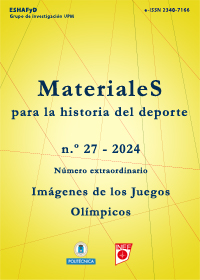The Mexico City Olympics and the image of altitude's influence on the success of Kenyan athletes
DOI:
https://doi.org/10.20868/mhd.2024.27.5076Keywords:
altitude, Mexico, Kenya, representation, environment.Abstract
Taking place at an altitude of 2,200 metres, the 1968 Olympic Games marked both the advent of Kenyan athletes on the world middle-distance running scene and the emergence of representations of the advantages that the altitude at which they lived would confer on them. These Games remain closely associated with the image of Kenyan athletes as bearers of a fantasised advantage linked to the natural environment in which they evolve. This representation reflects a French media construction that tends to devalue these athletes in a subordinate position in a sports space that is a vector of discrimination.
The study is based on the analysis of works on athletics in Kenya published in France, written by journalists, athletes or coaches and of the specialized French press through the issues of Le Miroir de l'athlétisme, l'Équipe athlétisme magazine, VO2 Magazine and l'Athlétisme.
The various observers took advantage of the geographical singularity of the Olympic site in Mexico City to euphemise, if not discredit, the Kenyan hegemony in the long races. This was due as much to their difficulty in separating themselves from a racialist vision of sporting performance as to a desire to preserve the faltering lustre of the French middle distance. Although controversial, the image of the influence of altitude brought to light at the Mexico Games has endured to the present day, despite the involvement of scientists to shed light on this phenomenon.
Downloads
References
Amossy, Ruth et Anne Herschberg-Pierrot. 2016. Stéréotypes et clichés. Paris : Armand Colin.
Attali, Michaël. 2018. “La presse sportive : militantisme, socialisation et modes d’appréhension du réel”. Dans Manuel d’analyse de la presse magazine, édité par Claire Blandin, 179-190. Paris : Armand Colin.
Baker, Joseph et Sean Horton. 2003. “East African running dominance revisited: a role for stereotype threat?”. British journal of sports medicine 37, n° 6 : 553-55.
Bale, John. 2002a. “Lassitude and latitude: Observations on sport and environmental determinism”. International Review for the Sociology of Sport 37, n° 2 : 147-58.
Bale, John. 2002b. “Finnish Dreams: A Modest Memoir”. The International Journal of the History of sport 29, n° 7 : 1080-89.
Bale, John et Joe Sang. 1996. Kenyan running: movement culture, geography, and global change. London : Routledge.
Bazoge, Natalia et Sandrine Jamain-Samson. 2013. “Les championnes de Miroir Sprint (1967-1970) : des modèles de ‘filles réussies’”. Dans Le sport dans la presse communiste, édité par Michaël Attali et Evelyne
Combeau-Mari, 231-248. Rennes : Presse Universitaire de Rennes.
Carrington, Ben. 2010. Race, Sport and Politics: the Sporting Black Diaspora. London : Sage.
Degraeve, Arnaud. 2023. “Réflexion épistémologique sur la suprématie des Africains de l’Est en course de longue durée : écart entre le discours journalistique français et les connaissances scientifiques disponibles sur la base de données Pubmed de 1960 à 2016”. Mémoire de Master, Université de Saint-Etienne.
Deville-Danthu, Bernadette. 1997. Le sport en noir et blanc : du sport colonial au sport africain dans les anciens territoires français d’Afrique occidentale (1920-1965). Paris : L’Harmattan.
Fleuriel, Sébastien, Bruno Papin et Baptiste Viaud. 2022. “Font-Romeu (1964–1972): A Review of the Social Conditions Behind the Creation of an ‘International’ Sports Center”. Sport History Review 53, n° 2 : 208-24.
Gaucher, Julie. 2009. “Black males in the stadium: All ‘bad niggers’? French literature, sport and masculinity from the 1920s to the 1950s”. The International Journal of the History of Sport 26, n° 9 : 1171-86.
Gaudin, Benoît. 2022. Coureurs de fond est-africains. Comment expliquer leurs compétences sportives. Paris : L’Harmattan.
Jobert, Timothée. 2006. Champions Noirs, Racisme Blanc : La Métropole et les Sportifs Noirs en Contexte Colonial (1901-1944). Grenoble : Presses Universitaires de Grenoble.
Jordan-Joung, Rebecca et Katrina Karkazis. 2019. Testosterone. An unauthorized biography. Cambridge : Harvard University Press.
Kasperowski, Dick. 2019. “Constructing altitude training standards for the 1968 Mexico Olympics: the impact of ideals of equality and uncertainty”. The International Journal of the History of Sport 26, n° 9 : 1263-91.
Levine, Benjamin D. et James Stray-Gundersen. 1997. “’Living high-training low’: effect of moderatealtitude acclimatization with low-altitude training on performance”. Journal of applied physiology 83 : 102-12.
Manners, John. 1997. “Kenya's running tribe”. Sports Historian 17, n° 2 : 14-27.
Martin-Breteau, Nicolas. 2010. “’Un laboratoire parfait’? Sport, race et génétique : le discours sur la différence athlétique aux Etats-Unis”. Sciences sociales et sport 1 : 7-43.
Martin-Breteau, Nicolas. 2013. “Sport, race, et politique : Taboo et la réception du discours sur les aptitudes athlétiques des races aux États-Unis”. Le mouvement social 242, n° 1 : 131-47.
Moore, Brian, Robien Parisotto, Craig Sharp, Yannis Pitsiladis et Bengt Kayser. 2007. “Erythropoietic indices in elite Kenyan runners training at altitude: effects of descent to sea level”. Dans East African Running. Toward a cross-disciplinary perspective, édité par Yannis Pitsiladis, John Bale, Craig Sharp et Timothy Noakes, 199-214. London : Routledge.
Mudimbe, Vincent. 2021. L’invention de l’Afrique. Gnose, philosophie et ordre de la connaissance. Paris : Présence africaine.
Onywera, Vincent O., Robert A. Scott, Michael K. Boit et Yannis P. Pitsiladis. 2006. “Demographic characteristics of elite Kenyan endurance runners”. Journal of sports sciences 24, n° 4 : 415-22.
Pitsiladis, Yannis, John Bale, Craig Sharp et Timothy Noakes. 2007. East African Running. Toward a crossdisciplinary perspective. London : Routledge.
Roger, Anne. 2010. “L’entraînement des coureurs français (1945-1970). À la recherche d’une méthode ‘française’”. Cahiers de l'INSEP 46, n° 1 : 104-17.
Sacco, Francesca et Gérald Gremion. 2001. “Le mythe de l’‘avantage génétique’ des sportifs africains”. Schweizerische Zeitschrift für Sportmedizin und Sporttraumatologie 49, n° 4 : 149-52.
Saïd, Edward W. 2005. L’Orientalisme : l’Orient créé par l’Occident (traduit par Catherine Malamoud). Paris : Seuil.
Saltin, Bengt, Henrik Larsen, Nicolàs Terrados et al. 1995. “Aerobic exercise capacity at sea level and at altitude in Kenyan boys, junior and senior runners compared with Scandinavian runners”. Scandinavian
journal of medicine & science in sports 5, n° 4 : 209-21.
Schotté, Manuel. 2012. La construction du “talent”. Sociologie de la domination des coureurs marocains. Paris : Raison d’agir.
Sikes, Michelle. 2016. “Print media and the history of women’s sport in Africa: The Kenyan case of barriers to international achievement”. History in Africa 43 : 323-45.
Sudre, David. 2022. “La représentation des adolescentes dans les films de sport. Analyse d’une image stéréotypée et régressive des jeunes sportives à l’écran”. Agora débats/jeunesses 91, n° 2 : 37-51.
Svedenhag, J., Bengt Saltin et al. 1991. “Aerobic and anaerobic exercise capacities of elite middle‐distance runners after two weeks of training at moderate altitude”. Scandinavian Journal of Medicine & Science in Sports 1, n° 4 : 205-14.
Terret, Thierry et Anne Roger. 2009. “Managing Colonial Contradictions: French Attitudes toward El Ouafi's 1928 Olympic Victory”. Journal of Sport history 36, n° 1 : 3-18.
Thomas, Cyril, Pascal Charroin et Bastien Soule. 2020. “Les relations franco-kényanes dans les courses de fond: Un processus postcolonial singulier (1960–2019)”. Stadion 44, n° 1 : 204-25.
Thomas, Cyril. 2021. “Un processus postcolonial: la genèse de la domination kényane dans les courses de fond vue par la presse spécialisée française”. Sur le journalisme, About journalism, Sobre jornalismo 10, n° 2 : 138-51.
Thomas, Cyril, Pascal Charroin et Bastien Soulé. 2021. “De la curiosité à l’évitement: l’adaptation des instances françaises de l’athlétisme face à la domination du Kenya en course de fond”. Sciences sociales et sport 1 : 87-112.
Thomas, Cyril, Bastien Soulé et Pascal Charroin. 2022. “The Ambivalence of an Innovation: The Creation and Development of the European Cross Country Championships”. The International Journal of the History of Sport 39, n° 10 : 1153-77.
Wiggins, David K. 1989. “’Great Speed But Little Stamina’: The Historical Debate Over Black Athletic Superiority”. Journal of Sport History 16, n° 2 : 158-85.
Wilber, Randall L. et Yannis Pitsiladis. 2012. “Kenyan and Ethiopian distance runners: what makes them so good?”. International journal of sports physiology and performance 7, n° 2 : 92-102.
Wrynn, Alison M. 2006. “’A debt was paid off in tears”: Science, IOC politics and the debate about high altitude in the 1968 Mexico City Olympics”. The international journal of the history of sport 23, n° 7 : 1152-72.
Downloads
Published
Issue
Section
License
Authors who submit to this journal agree to the following terms:
- Author(s) keep copyright and guarantee to the journal the right to be the first publication of the work as licensed under Creative Commons Attribution-Noncommercial-ShareAlike 4.0 International as initial publication in this journal.
- Author(s) can establish additional agreements for non-exclusive distribution of the version of the work published in the journal (for example, to an institutional archives or to publish it in a book), with an acknowledgment of its initial publication in this journal.
- It is allowed and authors are encouraged to disseminate their work electronically (e.g, in institutional open archives or on their own website) before and during the submission process, as it can lead to productive exchanges, as well as a citation earlier and more of published work (See the Effect of Open Access).












